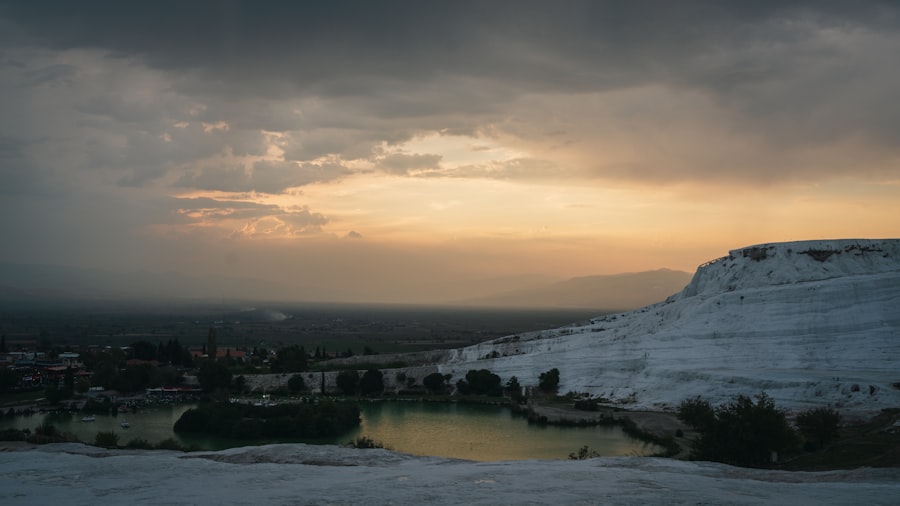Download links
How to install The Mysterious Beauty of Chocolate Hills APK?
1. Tap the downloaded The Mysterious Beauty of Chocolate Hills APK file.
2. Touch install.
3. Follow the steps on the screen.
Description
The Chocolate Hills, a geological wonder located in the Bohol province of the Philippines, are a striking natural phenomenon characterized by their conical shapes and lush green grass that turns brown during the dry season, resembling chocolate mounds. The formation of these hills is attributed to a combination of geological processes, primarily limestone erosion and the effects of weathering. Over millions of years, the region underwent significant geological transformations, where the uplift of coral deposits, once submerged under the sea, created a landscape rich in limestone.
This uplift was followed by extensive erosion caused by rainwater, which gradually sculpted the hills into their current conical forms. The process of karstification played a crucial role in shaping the Chocolate Hills. As rainwater percolated through the soil, it became slightly acidic due to dissolved carbon dioxide, which allowed it to dissolve the limestone more effectively.
This chemical weathering led to the formation of sinkholes and underground rivers, while the remaining limestone was sculpted into the iconic hills we see today. The unique topography of the area, with its rolling hills and valleys, is a testament to the dynamic geological history of Bohol. The Chocolate Hills cover an area of approximately 50 square kilometers and consist of over 1,200 individual hills, although estimates suggest there could be as many as 1,700.
Key Takeaways
- The Chocolate Hills were formed by the uplift of coral deposits and the action of rainwater and erosion over millions of years.
- The unique flora and fauna of the Chocolate Hills include various species of plants, birds, and mammals, some of which are endemic to the area.
- Local legends and myths surrounding the Chocolate Hills include stories of giants and forbidden love, adding to the mystical allure of the landscape.
- The best ways to experience the Chocolate Hills include hiking, biking, and taking a guided tour to fully appreciate the natural beauty and cultural significance of the site.
- Conservation efforts to protect the Chocolate Hills include reforestation projects, waste management initiatives, and sustainable tourism practices to preserve the area for future generations.
- The future of the Chocolate Hills faces threats from deforestation, climate change, and unregulated tourism, but also presents opportunities for sustainable development and eco-friendly initiatives to ensure its preservation.
The Unique Flora and Fauna of the Chocolate Hills
The biodiversity surrounding the Chocolate Hills is as remarkable as their geological features. The region is home to a variety of plant species that thrive in the unique environment created by the hills’ limestone composition. Grasses dominate the landscape, particularly during the dry season when they turn a rich brown color, giving rise to the name “Chocolate Hills.” However, this area is not devoid of other flora; several species of trees and shrubs can be found interspersed among the hills.
Notable among these are the endemic species such as the Bohol Bee-eater, a colorful bird that nests in the area and is often seen darting through the air in search of insects. In addition to avian life, the Chocolate Hills are also home to various mammals and reptiles. The Philippine tarsier, one of the world’s smallest primates, can be found in nearby forests and is known for its large eyes and nocturnal habits.
This tiny creature plays a vital role in maintaining the ecological balance of its habitat. The hills also provide a sanctuary for several species of butterflies and insects that contribute to pollination and serve as food for other wildlife. The unique interplay between flora and fauna in this region creates a vibrant ecosystem that is both delicate and resilient.
The Local Legends and Myths Surrounding the Chocolate Hills

The Chocolate Hills are steeped in local folklore and legends that add an enchanting layer to their already captivating presence. One popular legend tells the story of two giants who engaged in a fierce battle over a beautiful maiden. As they fought, they hurled boulders at each other, causing chaos across the landscape.
Eventually, they grew tired of their conflict and decided to bury their weapons and make peace. The boulders they had thrown transformed into hills, while their tears became the rivers that flowed through Bohol. This tale not only explains the origin of the hills but also reflects the rich cultural heritage of the local people.
Another legend speaks of a giant named Arogo who fell in love with a mortal woman named Aloya. When Aloya passed away, Arogo was heartbroken and wept for her loss. His tears formed the hills that we now know as the Chocolate Hills.
This poignant story highlights themes of love and loss while illustrating how natural phenomena can be intertwined with human emotions and experiences. Such myths serve not only as entertainment but also as a means for locals to connect with their environment, imbuing it with meaning and significance that transcends mere geography.
The Best Ways to Experience the Chocolate Hills
| Experience | Details |
|---|---|
| Viewing Points | There are several viewing points to see the Chocolate Hills from different angles. |
| ATV Adventure | Explore the Chocolate Hills on an ATV for an exciting and adventurous experience. |
| Zip Lining | Enjoy a thrilling zip line ride with a panoramic view of the Chocolate Hills. |
| Trekking | Take a trekking tour to get up close and personal with the unique landscape. |
| Cultural Immersion | Visit nearby villages to learn about the local culture and traditions. |
Experiencing the Chocolate Hills is an adventure that can be approached from various angles, each offering a unique perspective on this natural wonder. One of the most popular ways to take in the breathtaking views is from the Chocolate Hills Viewing Deck, which provides an elevated vantage point overlooking the rolling landscape. Visitors can climb up to this viewpoint via a series of steps that lead to an observation area where they can capture stunning photographs and appreciate the sheer scale of the hills.
The panoramic view is particularly mesmerizing during sunrise or sunset when the changing light casts shadows across the hills, enhancing their contours.
Guided tours often include visits to nearby attractions such as the Tarsier Sanctuary or local villages where visitors can learn about traditional Boholano culture.
Additionally, biking or ATV tours provide an exhilarating way to navigate through the terrain while enjoying close-up views of both flora and fauna. These activities not only allow for personal exploration but also foster a deeper appreciation for the natural beauty and cultural richness of Bohol.
The Conservation Efforts to Protect the Chocolate Hills
As a UNESCO World Heritage Site candidate, conservation efforts surrounding the Chocolate Hills are crucial for preserving this unique landscape for future generations. Local government units have implemented various initiatives aimed at protecting both the geological formations and their surrounding ecosystems. One significant effort includes establishing protected areas that restrict development and industrial activities that could threaten the integrity of the hills.
These protected zones are monitored regularly to ensure compliance with environmental regulations. Community involvement plays a vital role in conservation efforts as well. Local residents are encouraged to participate in educational programs that raise awareness about environmental stewardship and sustainable tourism practices.
Initiatives such as tree planting campaigns help restore native vegetation around the hills, which not only enhances biodiversity but also stabilizes soil and prevents erosion. By fostering a sense of ownership among locals regarding their natural heritage, these conservation efforts aim to create a sustainable balance between tourism and environmental protection.
The Future of the Chocolate Hills: Threats and Opportunities

While the Chocolate Hills stand as a testament to nature’s artistry, they face several threats that could impact their future viability. One significant concern is climate change, which poses risks such as altered rainfall patterns and increased frequency of extreme weather events. These changes could lead to soil erosion or degradation of local ecosystems, threatening both biodiversity and tourism potential.
Additionally, urbanization and agricultural expansion in nearby areas may encroach upon protected zones, leading to habitat loss and increased pollution. However, these challenges also present opportunities for innovation in conservation strategies and sustainable tourism development. By leveraging technology such as remote sensing and geographic information systems (GIS), researchers can monitor environmental changes more effectively and implement adaptive management practices.
Furthermore, promoting eco-tourism initiatives can help generate revenue while ensuring that local communities benefit from preserving their natural heritage. Engaging tourists in conservation efforts through volunteer programs or educational workshops can foster a deeper connection between visitors and the environment, ultimately leading to more responsible tourism practices. In conclusion, while threats loom over this iconic landscape, proactive measures can pave the way for a sustainable future for both the Chocolate Hills and their surrounding ecosystems.
By balancing conservation with community engagement and responsible tourism practices, there lies potential for these geological wonders to thrive for generations to come.
If you’re interested in exploring unique natural wonders like the Chocolate Hills, you may also enjoy reading about the benefits of fishing for the future in Indonesia. This article discusses the perspective and advantages of fishing for the future generations in Indonesia. Check it out here.
FAQs
What are the Chocolate Hills?
The Chocolate Hills are a geological formation located in the Bohol province of the Philippines. They are made up of around 1,200 to 1,776 conical limestone hills, which are covered in green grass that turns brown during the dry season, giving them a chocolate-like appearance.
How were the Chocolate Hills formed?
The exact formation process of the Chocolate Hills is still a subject of debate among geologists. One theory suggests that they are the weathered formations of a marine limestone on top of an impermeable layer of clay. Another theory proposes that they are the result of the uplift of coral deposits and the action of rainwater and erosion.
What is the significance of the Chocolate Hills?
The Chocolate Hills are a major tourist attraction in the Philippines and are considered a natural wonder. They have been declared the country’s third National Geological Monument and proposed for inclusion in the UNESCO World Heritage List.
Can visitors explore the Chocolate Hills?
Yes, visitors can explore the Chocolate Hills by climbing the viewing deck in the town of Carmen or by taking a guided tour. There are also hiking trails and ziplines available for those who want to experience the hills up close.
Are there any legends or myths associated with the Chocolate Hills?
According to local folklore, the Chocolate Hills were formed from the tears of a giant named Arogo, who wept over the death of his beloved. Another legend tells the story of two giants who hurled rocks and sand at each other in a fit of rage, and when they reconciled, they left behind the Chocolate Hills.





